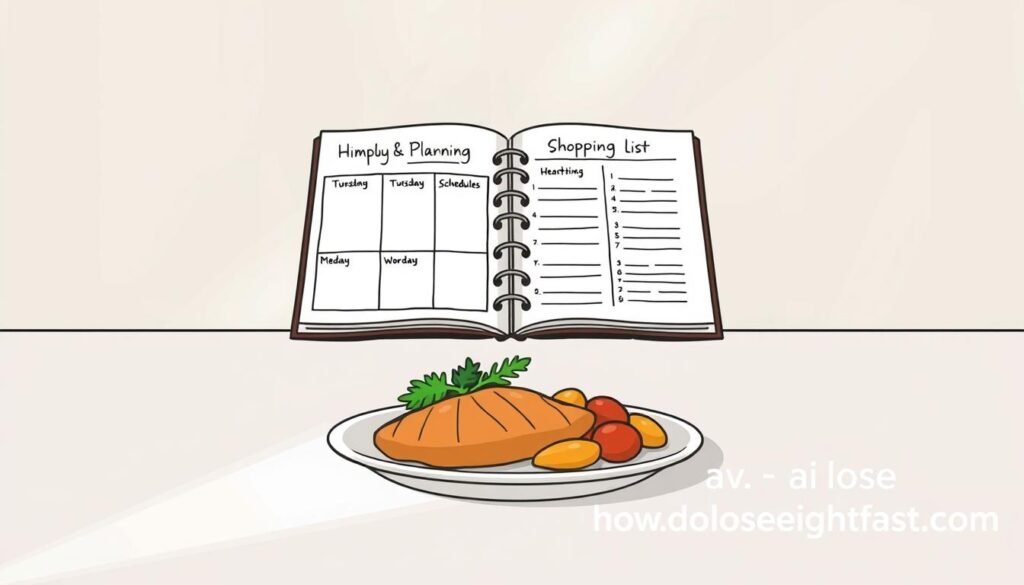Lose 10 Pounds in 7 Days: Simple Plan
Imagine stepping on the scale after a week of strict eating, only to see the number drop dramatically. Sarah, a busy mom of two, tried this exact approach last summer. She followed a popular three-day meal plan, swapped her usual snacks for celery sticks, and even skipped her morning latte. By day seven, she’d lost eight pounds—but within weeks, the weight crept back. Her story isn’t unique.
Many people turn to rapid results for immediate satisfaction, but what happens after day seven? This guide isn’t about selling shortcuts. Instead, we’ll show you how to approach short-term goals while building habits that last. You’ll learn why quick fixes often lead to temporary changes—and how to avoid common pitfalls.
Experts agree that most rapid weight loss comes from water, not fat. While seeing the scale move feels rewarding, maintaining progress requires smarter strategies. We’ll break down the science behind metabolism, hydration, and nutrition so you can make informed choices. Whether you’re preparing for an event or jumpstarting long-term goals, balance is key.
Key Takeaways
- Short-term plans often target water weight, not fat loss
- Extreme calorie restriction may slow your metabolism
- Combining smart nutrition with activity yields better results
- Hydration and sleep impact weight management
- Focus on habits, not just numbers on the scale
Ready to explore a balanced approach? Let’s dive into what really works—and how to keep your success going long after the first week.
Understanding the lose 10 pounds in 7 days plan
Rapid weight loss plans often promise dramatic changes, but the science behind them tells a different story. These methods rely on creating an extreme calorie deficit, forcing your body to tap into stored energy. While the scale might show quick results, most early changes come from fluid shifts rather than lasting fat reduction.
The Core Principles Behind Rapid Changes
Your body stores energy as glycogen—a carb-based fuel source bound to water. When you slash calories (like the 1,100-1,400/day military diet), glycogen depletes fast. For every gram lost, three grams of water get released. This explains why initial weight loss feels rapid but temporary.
Severe restrictions also trigger metabolic adaptations. Your system slows energy use to protect vital functions, making continued progress harder. This survival mechanism highlights why extreme plans rarely work long-term.
What Actually Disappears First
Early weight changes primarily reflect water loss, not fat reduction. Here’s how they compare:
| Factor | Water Weight | Fat Loss |
|---|---|---|
| Speed | Fast (1-5 days) | Slow (weeks+) |
| Source | Glycogen/fluid | Fat cells |
| Permanence | Temporary | Lasting |
| Calorie Impact | 3,500 deficit = 1lb | Same deficit needed |
While quick methods create immediate scale wins, true fat loss requires consistent effort over time. Balancing short-term actions with sustainable habits helps maintain results after the first week.
Fundamentals of Rapid Weight Loss
You’ve likely heard “eat less, move more” is the golden rule for shedding weight. But energy balance – calories consumed versus burned – works differently in rapid versus gradual approaches. A 2018 review found that cutting 500-600 daily calories creates steady progress, while extreme restrictions often backfire.

Calorie Restrictions and Energy Balance
Your body needs fuel to function, even at rest. Moderate deficits let you lose 1-2 pounds weekly while maintaining energy. Compare these approaches:
| Moderate Plan | Extreme Plan | |
|---|---|---|
| Daily Calories | 1,500-1,800 (men) 1,200-1,500 (women) |
1,100-1,400 |
| Weight Loss | Mostly fat | Water/muscle |
| Metabolism | Stable | Slows 15-30% |
Diets like the military plan ignore your unique needs – activity levels, genetics, and health factors. Severely limiting intake often causes fatigue, cravings, and nutrient gaps.
Short-Term Versus Sustainable Outcomes
Quick fixes might shrink your waistline temporarily, but here’s what really happens:
- Muscle loss reduces calorie-burning power
- Water weight returns quickly
- Metabolic slowdown makes maintenance harder
Gradual changes protect muscle, keep energy steady, and adapt to your lifestyle. As one nutritionist notes: “The scale lies – body composition tells the truth.” Building habits around balanced meals and activity creates lasting results without drastic measures.
Crafting a Simple and Effective Meal Plan
Creating meals that support your goals doesn’t require complicated recipes or expensive ingredients. With smart planning, you can enjoy satisfying dishes while managing calorie intake. Let’s explore how to build balanced plates that keep energy steady and cravings at bay.

Designing Breakfast, Lunch, and Dinner Strategies
Start your day with 300-calorie meals packed with protein and fiber. Try scrambled eggs with spinach or oatmeal topped with almond butter. For lunch, aim for 400 calories using lean proteins like grilled chicken or black beans paired with colorful vegetables.
| Meal | Traditional Choice | Smart Swap |
|---|---|---|
| Breakfast | Bagel with cream cheese | Whole-grain toast with avocado |
| Lunch | Caesar salad | Kale salad with grilled shrimp |
| Dinner | Buttered pasta | Zucchini noodles with salmon |
Incorporating Healthy Substitutions
Swap mayo in sandwiches for Greek yogurt mixed with herbs. Use cauliflower rice instead of white rice to slash calories while boosting vegetable intake. Portion control becomes effortless when you fill half your plate with non-starchy veggies like broccoli or bell peppers.
Choosing Nutrient-Dense Foods
Focus on foods that deliver maximum nutrition per bite. Opt for cottage cheese over processed snacks, and choose whole fruits instead of sugary desserts. “Prioritize quality calories—your body will thank you,” advises dietitian Laura Simmons. Pair these choices with mindful eating habits for lasting results.
Incorporating Exercise and Activity for Maximum Results
Movement becomes your secret weapon when paired with smart nutrition. While you might think cardio is king, combining different exercise types creates a powerful synergy. This approach helps manage weight while shaping your body’s composition for lasting results.
Choosing the Right Physical Exercises
Start with 30 minutes of brisk walking or cycling five days weekly. These moderate activities boost heart health while burning calories. Gradually add resistance training twice weekly—bodyweight exercises like squats or push-ups work wonders for beginners.
High-intensity interval training (HIIT) offers time-efficient calorie burning. A 20-minute session alternates bursts like jumping jacks with recovery periods. “HIIT triggers an afterburn effect,” notes fitness coach Mark Ramirez. “Your body keeps burning fuel for hours post-workout.” Always consult a doctor before trying intense routines.
Building Lean Muscle to Boost Metabolism
Strength training does more than tone—it transforms your body into a calorie-burning machine. For every pound of muscle gained, you’ll burn 6-10 extra calories daily at rest. Try this comparison:
| Activity | Calories/Hour | Metabolism Boost |
|---|---|---|
| Cardio | 400-600 | 0-2 hours |
| Strength Training | 200-400 | 24-36 hours |
Incorporate daily movement beyond workouts. Take stairs instead of elevators, or try a walking routine during phone calls. These small changes add up, keeping your energy high and progress steady.
Mindful Eating and Healthy Habits
What if your relationship with food could become your greatest ally in achieving wellness? Tuning into your body’s natural signals transforms how you approach meals. This isn’t about strict rules—it’s about building awareness that supports both physical and mental health.
Listening to Your Hunger Signals Effectively
Registered dietitian Kayla Kopp suggests using a hunger scale from 1 (starving) to 10 (stuffed). Aim to eat when you’re at a 4-6 and stop before reaching 8. This simple tool helps you avoid overeating or making impulsive food choices.
| Physical Hunger | Emotional Hunger |
|---|---|
| Develops gradually | Strikes suddenly |
| Stops when full | Craves specific foods |
| Occurs every 3-4 hours | Linked to stress/boredom |
Psychologist Susan Albers notes that 75% of eating stems from emotions rather than true hunger. Recognizing this difference helps you respond to your body’s actual needs.
Strategies for Mindful Eating and Stress Management
Start meals by asking: “Am I hungry, or am I seeking comfort?” Create distraction-free zones—turn off screens and focus on flavors. Chew slowly to give your mind time to register fullness.
Manage stress with these techniques:
- Practice 4-7-8 breathing before meals
- Take a 10-minute walk when cravings hit
- Keep a journal to track emotional triggers
Sleep plays a surprising role too. Missing just one hour raises hunger hormones by 15%, making healthy choices harder. Aim for 7-9 hours nightly to keep appetite in check.
Navigating Dietary Adjustments Safely
Making lasting changes to your eating habits doesn’t require drastic overhauls—small shifts create big impacts over time. Instead of slashing calories overnight, think of your body as a thermostat that needs gradual temperature changes. Research shows cutting just 200-300 daily calories while boosting nutrient quality helps maintain energy and prevents metabolic slowdown.
Smart Swaps for Sustainable Progress
Start by replacing one processed item daily with a whole-food alternative. Try these easy switches:
| Processed Food | Whole Food Swap | Calorie Difference |
|---|---|---|
| Potato chips | Air-popped popcorn | -120 per serving |
| Sugary cereal | Oatmeal + berries | -90 per bowl |
| White bread | Whole-grain bread | +3g fiber/slice |
A 2014 study warns: “Crash diets increase emotional eating risks by 34% compared to gradual approaches.” Focus on nutrient density—choose foods packed with vitamins per calorie, like spinach over iceberg lettuce.
Learn to read labels like a pro. Check serving sizes first—many packages contain multiple portions. Look for ingredients you recognize. If the list includes hydrogenated oils or high-fructose corn syrup, consider healthier alternatives.
Watch for these red flags:
- Constant fatigue during daily activities
- Obsessive thoughts about food rules
- Dizziness or irregular menstrual cycles
Remember: Your health matters more than speed. Small tweaks today build habits that support lasting weight management without deprivation.
Staying Motivated and Overcoming Plateaus
True progress isn’t measured by a single number—it’s found in how your clothes fit, the energy you feel chasing your kids, or the confidence from climbing stairs without gasping. Focus on these wins rather than letting the scale dictate your self-worth. Studies show people who track multiple success markers stick to healthy habits 40% longer than those obsessed with weight alone.
Measure What Matters Beyond Numbers
Snap weekly progress photos. Notice how rings fit looser or jeans zip easier. Track energy spikes during workouts. These tangible signs often reveal changes before the scale does. As one Journal of Behavioral Medicine study found: “Non-scale victories boost long-term commitment better than pound-counting.”
Build Goals Around Feeling Stronger
Instead of “lose X pounds,” aim for actionable targets like “walk 30 minutes daily” or “add veggies to two meals.” Time-bound goals work best—try “improve sleep quality within three weeks.” Celebrate when you hit these marks with non-food rewards like new workout gear.
Refresh Your Approach Strategically
If progress stalls, don’t slash calories further. Try these expert-backed ways to reboot:
- Swap walking routes to challenge muscles differently
- Increase protein intake by 10-15 grams daily
- Consult a dietitian for personalized tweaks
Remember: Plateaus mean your body’s adapting—not failing. Keep adjusting your plan while honoring how far you’ve come.
FAQ
Is losing 10 pounds in a week safe?
Rapid weight loss often involves shedding water weight first, which can create quick results. However, drastic calorie restriction may not be sustainable or healthy long-term. Always consult a healthcare provider before starting extreme plans to ensure your body’s needs are met safely.
How much of the initial weight loss is water weight?
In the first few days, your body may release stored water, especially if you reduce carb intake. This can account for 2–5 pounds of initial loss. Fat reduction requires consistent calorie deficits over time, paired with physical activity.
What foods help maximize results without hunger?
Focus on nutrient-dense choices like leafy greens, lean proteins (chicken, fish), and high-fiber veggies. Swap refined carbs for whole grains, and use herbs or spices instead of high-calorie sauces. These swaps keep meals satisfying while supporting your goals.
Can exercise speed up the process?
Yes! Combining cardio (like brisk walking) with strength training helps burn calories and build lean muscle. Muscle tissue burns more energy at rest, which can boost metabolism. Aim for 30–60 minutes daily, but listen to your body to avoid overexertion.
How do I avoid regaining weight afterward?
Transition gradually to a balanced diet with moderate calorie intake. Prioritize whole foods, monitor portions, and maintain regular activity. Tracking habits with apps or journals helps reinforce accountability and identify patterns that support lasting success.
What if I hit a plateau during the week?
Plateaus are common as your body adapts. Shake things up by adjusting workout intensity, trying new recipes, or reevaluating portion sizes. Staying hydrated and managing stress through mindfulness can also reignite progress.
How can mindful eating prevent overeating?
Pay attention to hunger cues—eat slowly, savor each bite, and stop when comfortably full. Avoid distractions like screens during meals. Drinking water before eating and using smaller plates also help control portions naturally.
Are there risks to extreme calorie cutting?
Severely limiting intake can lead to fatigue, nutrient deficiencies, or muscle loss. Instead of drastic cuts, aim for a moderate deficit (500–750 calories daily) and prioritize protein to preserve muscle mass. Always prioritize long-term health over short-term fixes.

